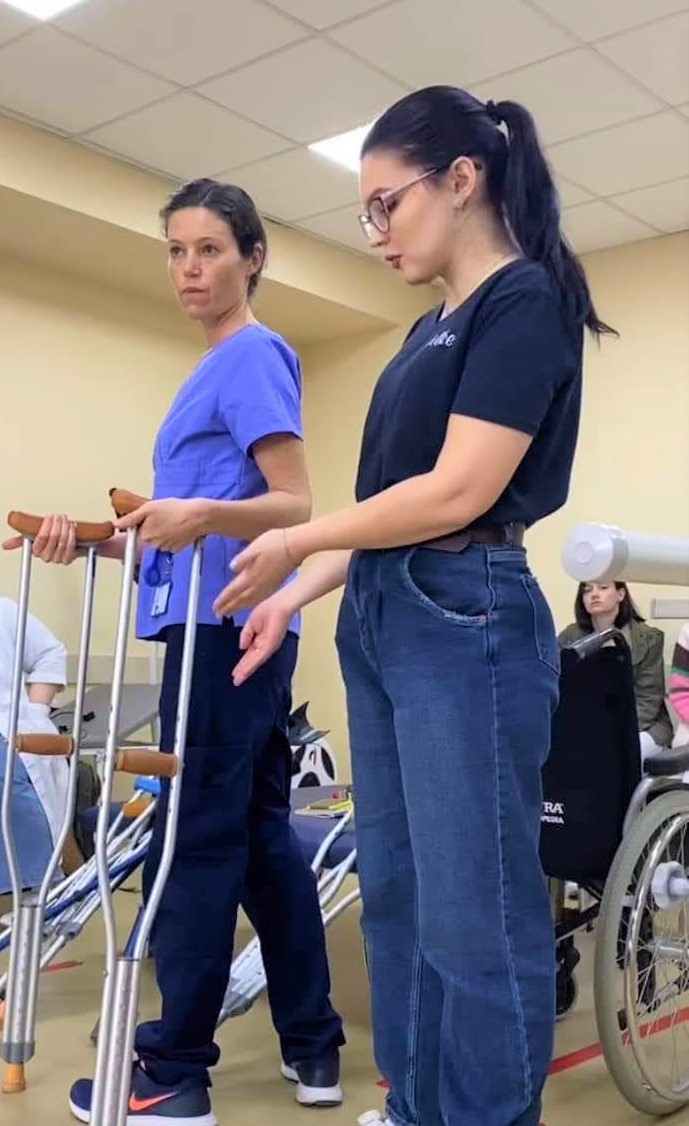What kinds of patients are we seeing in the East of Ukraine?
 “The hospital where Humanity & Inclusion (HI) is working in Dnipro receives war-wounded individuals and stabilizes them before they are transferred to the West. We were receiving a significant number of “poly-traumas,” which are not just one type of injury, but several wounds inflicted by blasts of explosive weaponry.
“The hospital where Humanity & Inclusion (HI) is working in Dnipro receives war-wounded individuals and stabilizes them before they are transferred to the West. We were receiving a significant number of “poly-traumas,” which are not just one type of injury, but several wounds inflicted by blasts of explosive weaponry.
Blasts from explosive weapons put people at risk of multiple different kinds of injuries at once. First, pressure from the blast can impact your lungs, ears, eyes, and intestines. The explosion itself or fragments and shrapnel from the explosion can lead to broken bones and flesh wounds, which could require amputation. Upon impact after a blast, you may get traumatic brain and spine injuries from the collision. Finally, there are burns to the skin and even respiratory damage as you breathe in smoke, dust and chemicals. In Dnipro, the patients presented with a mix of all these injuries. Some of these injuries on their own can be serious, and then when you put them together, it’s staggering.
One of our patients needed a full jaw reconstruction, and couldn’t open his mouth or swallow. He required surgical procedures to help support his breathing and clear his chest through internal draining. He also had broken vertebrae in his spine. Managing respiratory problems in a patient with an unstable fractured spine is very complex. Staff have to understand the priorities and precautions when looking at four or five combined injuries and then how to clearly explain it to the patient, who may not be in the hospital for very long.”
How is HI helping hospitals respond to these needs?
“One of the ways HI supports the response is by providing theoretical and on-the-job practical training to physical rehabilitation staff (PRM[1] doctors, physical therapists and occupational therapists). The focus was primarily war-wounded patients. I was working directly with the rehabilitation team in one hospital to do on-the-job training and then in the afternoons I would have a training course that was open for staff from other clinics and hospitals to come and receive training on early rehabilitation for war-wounded individuals. Where I was working, there was an absolutely phenomenal level of skill and they are doing an incredible job of stabilizing patients. But the needs are enormous and these are different kinds of patients than they are used to in early rehabilitation, so general support to build confidence in their skills is important.”
Why do patients need early rehabilitation?
“Our goal is to prevent further complications. Any one injury will always come with a list of potential problems. So, when you have multiple injuries, they each have their own risks that affect recovery. There is great value in getting people to move safely. If they stay immobile for too long, patients risk circulation problems and their joints lose mobility. Even three or four days of not moving can have a huge impact on your body. It doesn’t take long to start deteriorating, and then recovery can be quite difficult.
Someone may not be able to move their left leg after an injury or surgery, but they still have a functioning right leg, core muscles and upper limbs that need to move regularly to prevent deterioration, long-term problems and promote functional recovery.”
What kinds of complications can occur?
“When we talk about physical rehabilitation, we have to think about the whole body. It does not mean only skin and muscles, but also the nervous system and vital organs. Your heart depends on your lungs and one of the biggest issues we see are respiratory complications. If people can’t cough and clear their lungs effectively, they are at risk of pneumonia or respiratory failure, which can be fatal. Low levels of oxygen from poor or damaged circulation can also lead to tissue death, which is not compatible for injury recovery. There are numerous rehabilitation techniques to help patients breathe more easily depending on their condition, but one of the best ways is for the patient to get up and be mobile. Here again, we see the importance of early rehabilitation to improve mobility.
A lot of what you do physically also has an impact on your well-being, which can then influence your recovery. We have had patients who hadn’t been outside in six weeks, which affects their mental health. We also saw a lot of elderly persons who had developed health and neurological conditions due to extended periods of time sheltering indoors before they were evacuated. So, just getting them mobile enough, often with the support of assistive devices, to go outside can make a big change to their well-being.”
[1] Physical Medicine and Rehabilitation



 “The hospital where Humanity & Inclusion (HI) is working in Dnipro receives war-wounded individuals and stabilizes them before they are transferred to the West. We were receiving a significant number of “poly-traumas,” which are not just one type of injury, but several wounds inflicted by blasts of explosive weaponry.
“The hospital where Humanity & Inclusion (HI) is working in Dnipro receives war-wounded individuals and stabilizes them before they are transferred to the West. We were receiving a significant number of “poly-traumas,” which are not just one type of injury, but several wounds inflicted by blasts of explosive weaponry.
